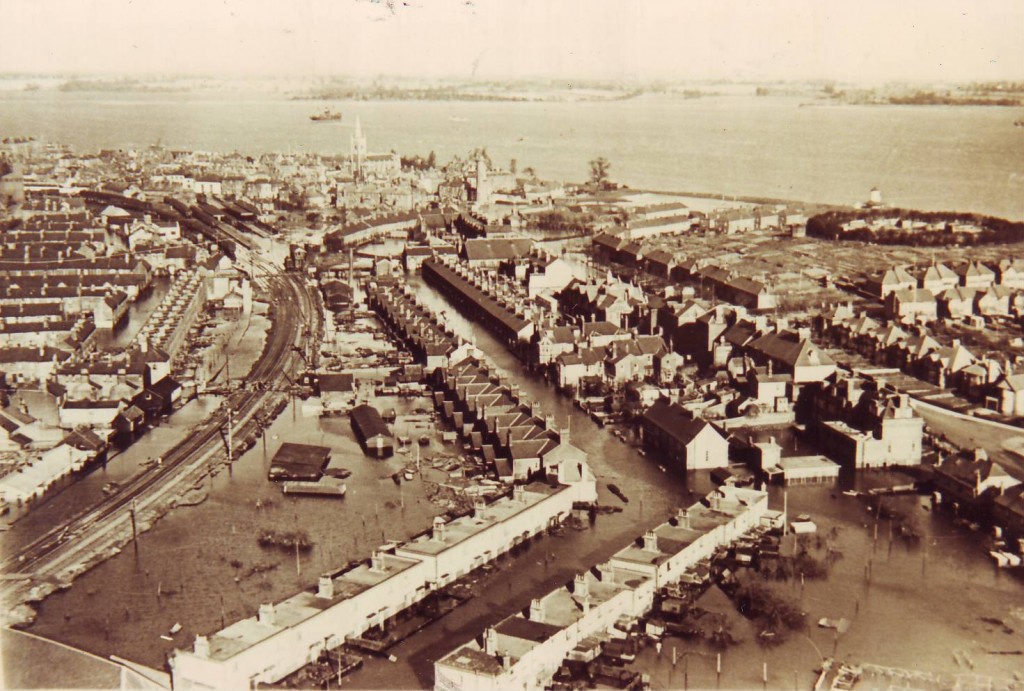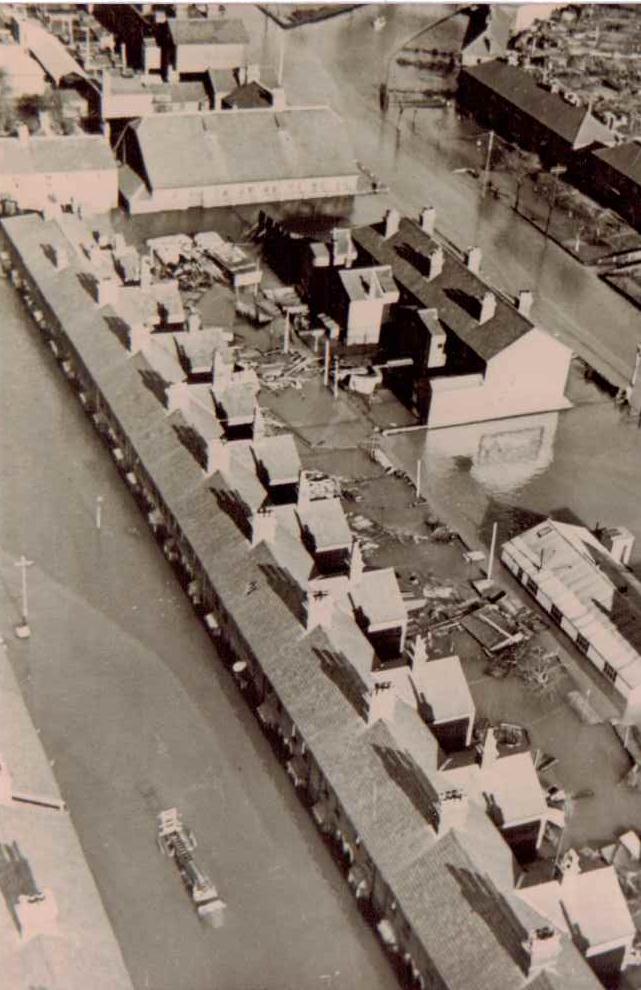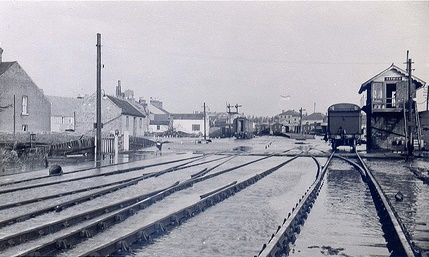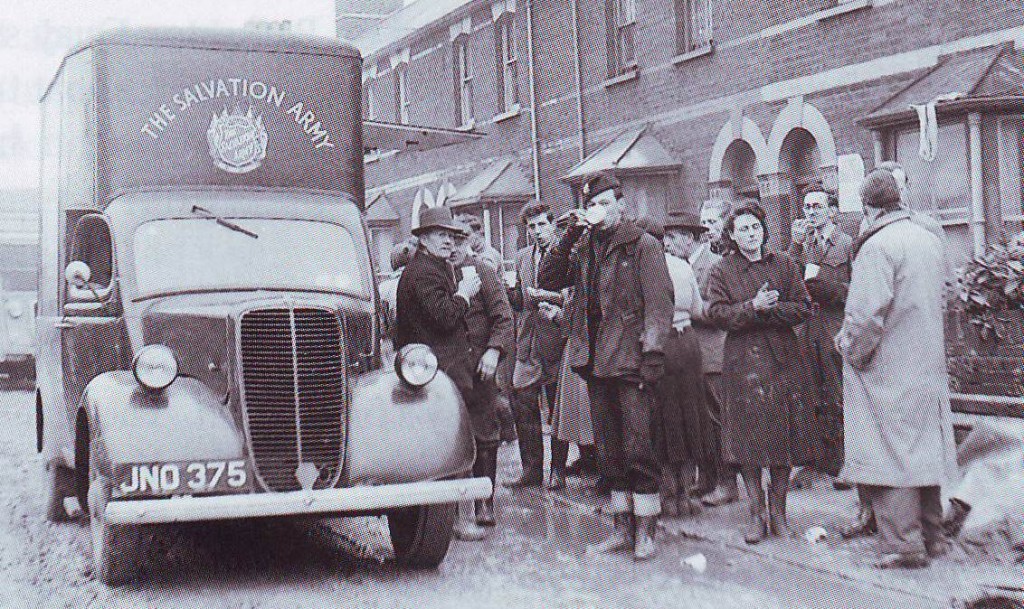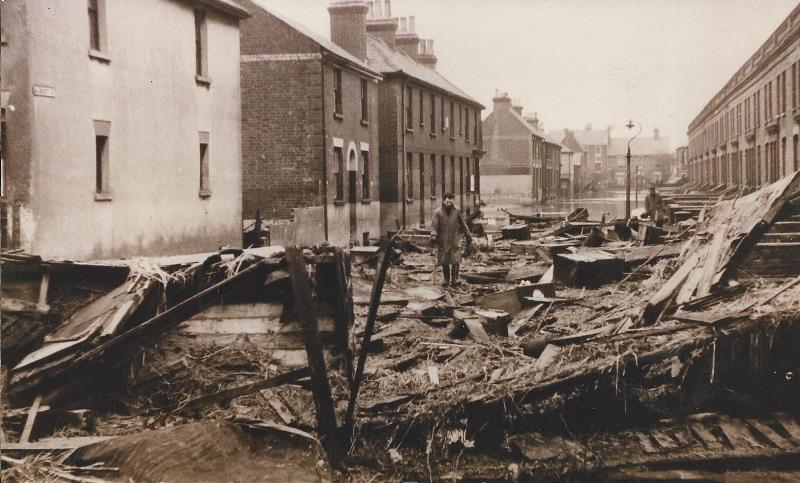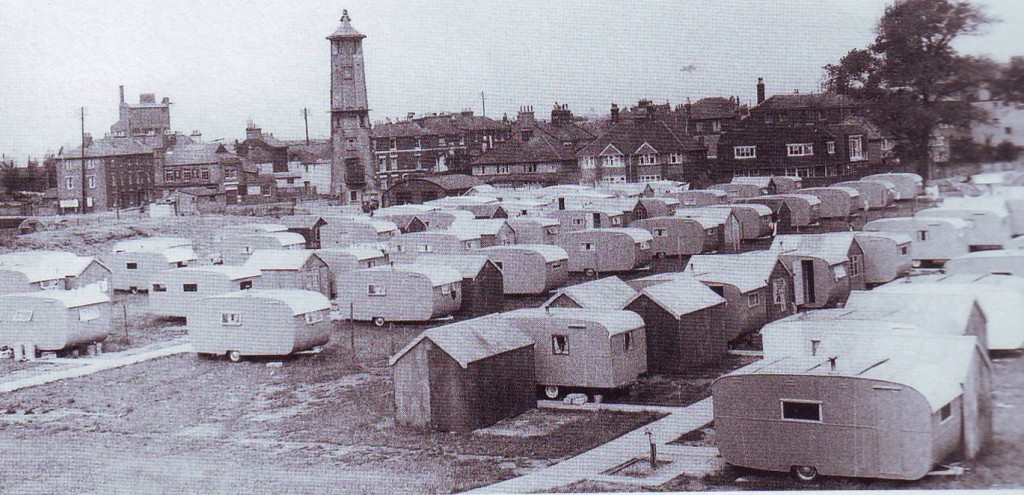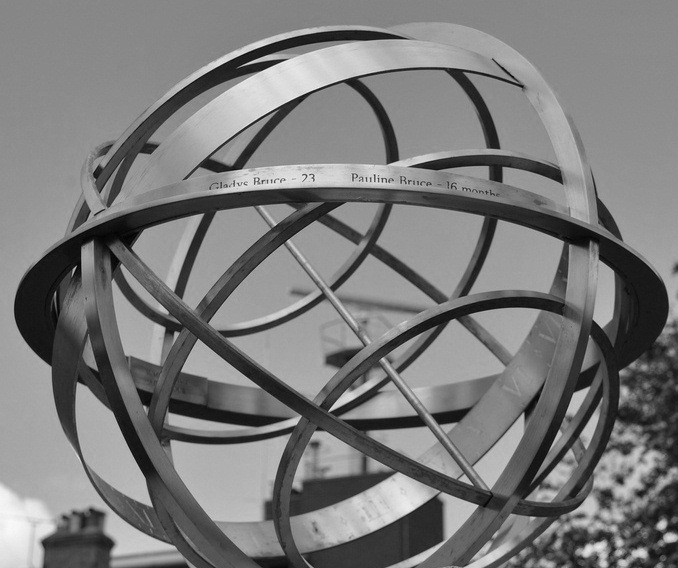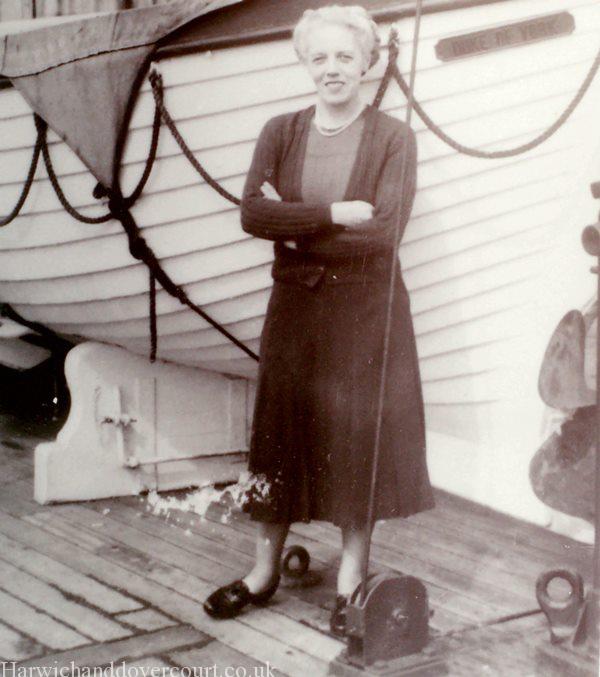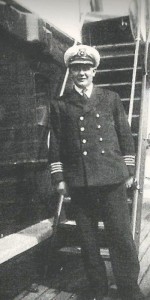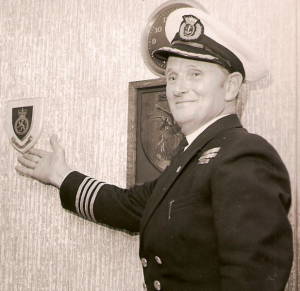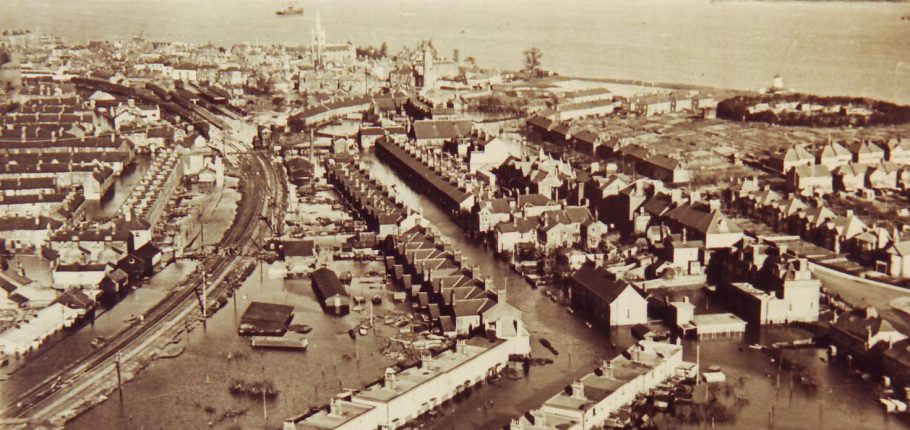
A Memorable Year
-
HOW A TINY BOROUGH BECAME
-
‘THE TOWN MOST IN THE NEWS,
THE HARWICH STORY, 1953
Tragedy, success, disaster, made up 1953’s news
From the flood to Wembley, from shipping disasters to the town’s own football pool
For many years to come Harwich folk will be wont to say “Do you remember 1953?” And what cause for memories will everyone have who lived in the twelve historic months.
Tragedy, disaster, success, the unusual, all have played their part in keeping the name of Harwich in the national news, in deed in the international news. The Standard, January 1, 1954.
January
The year started quietly enough, with little indication of the fact that Harwich was to hit the national headlines on more than one occasion.
Plans were already being made for celebration of the coming Coronation. Arrival of “off the shelf” licences for the building of private houses was welcomed with mixed feelings by local builders and it was thought that residential development of Dovercourt was not likely to be much affected in the immediate future because there were few plans for big housing estates.
February
Apart from the flood, main event on the tongues of local people was the “Shrimpers” shock soccer victory in defeating Leytonstone 4-3. This put then into the semi-final of the F.A. Amateur Cup for the first time since 1899. The second half of the game was televised.
One of the Parkeston boats, the Arnhem, carried out a rescue during the first week of the month when she picked up 58 survivors after a collision between the Swedish ship Rigel and the Italian ship Senegal.
Harwich Flood Disaster
On the night of Saturday 31, 1953, people were sleeping peacefully in their beds. Seconds later they were fighting for their lives as relentless seawater tore through their homes. Throughout history, the sea has been both friend and foe of the British Isles. Storms at sea have repelled invaders, but they have also unleashed severe floods to attack the island’s shores and their communities.
At 21.45 on 31st January, Harwich Harbour Master notified the Harwich Police Station of an exceptional high tide timed for 00.50 the following morning. By 22.30 water was already lapping over Harwich Quay. The town was simultaneously attacked from three sides and by midnight water was pouring in from the east, North and west. The quay, the esplanade and Bathside area were all flooded And the pier submerged. The water in Bathside piled up between Stour Road and the railway embankment.
Headline from Harwich & Dovercourt Standard Friday February 13th 1953.
Immense task of rehabilitating Harwich after the devastation caused by flooding is being tackled in two sections. People are to be allowed to return to houses on the town side of the railway line as soon as a “clearance” certificate is given. The Bathside area, where 280 properties were completely flooded, is to be a prohibited area for residential purposes. The whole of Harwich from the quay to the police station lay Huddled in several feet of water. Three thousand people were homeless. Great lumps were washed out of the railway embankment, Harwich town station was flooded, the continental pier damaged and the train ferry berthing gear put out of action .
The First 24 Hours
Details taken from local Police records covering the event which shows details of the work undertaken by the Police and other rescue workers.
31/1/1953 9.45pm. The Harwich Harbour-Master notified the Police Station that he anticipated an exceptionally high tide at 0050 hours 1.2.53, with a possibility of some flooding. 10.30pm The Inspector and Sergeant went to Harwich Quay to inspect the level of the tide, and en route warned Harwich Fire Station of possible later danger. They found water lapping over the quay, and decided to warn local residents. With a Constable, they called at houses and asked the people to inform their neighbours. Unfortunately the warnings were not always taken seriously, because of previous flooding involving a few inches of water only. At 10.45pm telephonic application was made by the Inspector for a car with loudspeaker equipment, but the gale had put radio communications of out of order and the car could not be contacted. 11.00pm Leaving the Constable warning the residents in Harwich the Inspector and Sergeant went to Bathside. In the moonlight it could be seen that the Bathside Sea Wall was being severely pounded by the sea, and they started to warn people living in Bathside that basements might be flooded, and advising them to remain in upper rooms. At this time the sea wall was holding and the basin was empty.
11.20pm. The Inspector retuned to the Police Station to report the position to his senior officer at Clacton, and arrange for other officer off duty to be called to assist with the warnings.
11.55pm.The Sergeant reported at the Police Station that the Bathside Sea Wall had given way and water was flooding into Bathside like a tidal wave. Inspector and Sergeant went to survey the position and in a few minutes that had elapsed Bathside had about 3’6” of water in it. The Sergeant waded in to encourage the householders, who could be heard shouting for help, and the Inspector returned to the station to call out all personnel living in the district. The general position in Bathside was chaotic, and a full gale was blowing.
Arrangements were immediately put in hand for all Police to be called out, by telephone and by runner.
1/2/53 12.10am. The Station Officer of Harwich Fire Brigade reported at the Police Station with his men. The Fire Station had been flooded, and emergency accommodation was requested and immediately provided in the Police Station. The Inspector of Police, with a Sub-Officer of the Fire Brigade and two firemen, using a jeep, attempted to get into Bathside from two different points, Anchor public house and the Fernlea road level crossing, to rescue persons who it was known would be in danger in ground floor flats. Owing to the prevailing conditions they were unable to get in, and returned to the Police Station having to abandon the jeep on the way.
12.30am.The Inspector and Sergeant returned to the Station, which was now being flooded. The water was rising rapidly and a few minutes later the lights failed- the Fire Service quickly proved emergency lighting. In the meantime telephone warnings of the position had been made and were being sent from the Police Station to member of the Local Authority.
12.40am.The Inspector had his first Conference on plans to deal with that was obviously a catastrophe, with his two Sergeants available. Provisional plans were made for such items as the recovery of persons drowned, the rescue of any trapped when the water went down, searching of all houses, temporary housing and feeding, registration of those who would have to leave their homes for an estimated minimum of 48 hours, security of property, control of traffic, and general control of all movements in the area.
The Military Commandant at the Harwich Embarkation Establishment was requested to stand by to assist if necessary, and to arrange for the Frill Hall at Harwich to be heated, and prepared to accommodate several hundred homeless persons.
By this time the water in the Police Station was about 7” deep, and about 40 people had flocked into the Station for help and advice.
1.30pm.The first Conference between the Police and the Local Authority was held at the Police Station, between the Inspector, the Town Clerk, the Sanitary Inspector, and other officials. The Town Clerk took over the arrangements for housing, feeding, clothing and general welfare, and the Sanitary Inspector took such steps to get his staff prepared to have all sewage pumps working as early as possible to help get rid of the water, and issued instructions regarding warnings to the public on contamination of water.
3.00pm. A second Conference between Police, Town Clerk, Sanitary Inspector, Borough Surveyor, and Chief Fire Officer, was held, to decide the action to be taken in view of the changed circumstances. The main item was whether Stour Road should be breached with the Railway Embankment, to allow the water to run away, but it was decided that the breach could not be sealed before the next high tide.
The Police had the responsibility of rescue work, and set about finding the required boats with which to carry out the task. Police Officers, assisted by willing local people, contacted boat owners, the Reserve Fleet at Harwich, H.M.S. Ganges at Shotley, Trinity House, and local fishermen, and arranged for a collection of boats to be collected by Military Vehicles and transported to a site near the Police Station, in readiness for daylight when the rescue operation could commence.
4.00pm. The first organised search of flooded premises was started, by parties consisting of a Police Constable, a Firemen, and 6 soldiers, assigned one party to each street, in part of Harwich Town which by now had been cleared of water by the ebbing tide. The search was concluded in about an hour and fortunately no casualties were located.
Daybreak. At daybreak the rescue work commenced. The whole operation was supervised by the Police, and the boats were manned by Police, Firemen, and Sailors, boys from H.M.S. Ganges, Harwich Fishermen, and local residents. The trapped persons were taken from their houses in small boats, via windows, and conveyed to five different landing points, where they were met and conveyed to the Reception Centre.
Shortly after daybreak officials of business premises in Harwich arrived to deal with the salvage of their equipment and records.
11.00am. The rescue operation was now well under way, traffic and security arrangements were working, and the Chief Police Officer called a conference at the Police Station. All those attending the Conference reported their progress to date, difficulties encountered in which other Services could help, and intended action and anticipated progress during the following 24 hours.
Sunset 1.2.53. The rescue work was completed, and over 1,000 persons had been safely brought from their homes to the landing points, and taken to other accommodation.
At the anchor public house the landlord and his wife had gone down the cellar to try and remove some of the smaller barrels of beer to safety. Simultaneously water burst in from the street through three doors at once. The landlord’s wife managed to escape, but the rush of water slammed the cellar door behind her, sweeping her up to the top of the stairs. her husband was trapped in 15ft of water below. Rescuers had to cut through the floor of the bar to reach the body.
Harwich begins the Great tidy up
The tidying-up after the flood has started at Harwich. As soon as the flood waters went down people began to move towards their homes, to reoccupy them if they had been only partially flooded, to retrieve personal belongings they could where the flooding had been most severe. All this week Lorries have been carting away the mounds of sodden carpets and linoleum which house holders have turned out of their houses. Pianos and pieces of furniture, swelled and broken by their immersion in water forlornly outside houses, and all the time there is a sad procession of people pushing barrows with bundles of clothing and bed linen which they have been able to retrieve from their broken homes.

Police Checkpoint
Queue for passes. Saturday and Sunday were days of tremendous activity and there were queues at Harwich police station for the necessary “pass” to enter the Bathside area where only clothing, bed linen and small personal belongings may be removed from the houses. at Grafton Road the police officer on duty kept a close check on those who passed his little sentry box. There were plenty who did pass, not only the householders. Operation Canute” When the Army went into action at the outset of the Harwich flood they did it in Army style “Operation Canute” it was quite an operation, and one which will live for years to come in the memories of many. Combining with all the other gallant organisations that played such a heroic part in the rescue and comfort of thousands of homeless Harwich people, the staff at the Harwich Transit Camp did possibly the best job of all, they brought dozens of boats to the edge of the flood water in their huge Lorries, transported hundreds of people to the camp, and there they threw open their billets, fed the evacuees in the NAAFI opened the Unit dining hall as clothing a relief centre, and generally performed as task which no other single unit in the town could have done. Besides all this the camp still managed to perform its routine task of shipping some thousands of B.A.O.R. troops to and from Hook of Holland.
In March 108 caravans were sited on St Helen’s Green and the Barrack Field for the Bathside residents. the caravan dwellers were there for up to two years and had to endure one of the coldest winters on record. Eight people lost their lives, including a mother and baby and a man who lost his Life trying to save them. 280 properties in Bathside alone were flooded.
A night that I will never forget
January 31, 1953, was a very rough day. The wind was howling and the rain was beating down like hail stones. the wind had reached gale force. the sea was very angry – big waves swept along the cliffs and boats were banging together in the harbour. I did not think anything about it – only being 12 years old at the time, without a care in the world. during the night, I was awoken by an awful noise; it seemed as if I could hear water rushing all over the place. I started to shout for my mother, but the noise was so loud that she could not hear me. then I hear my Nan say, “Oh God”, and she came running up the stairs. My Nan came into my bedroom with my mother – they looked very worried. the water was rushing up the stairs with enormous force. All of a sudden, the lights went out. It was very dark. My mother opened the window. Everyone was shouting and making a noise. I looked out of the window and saw that the water was halfway up the house and still rising.
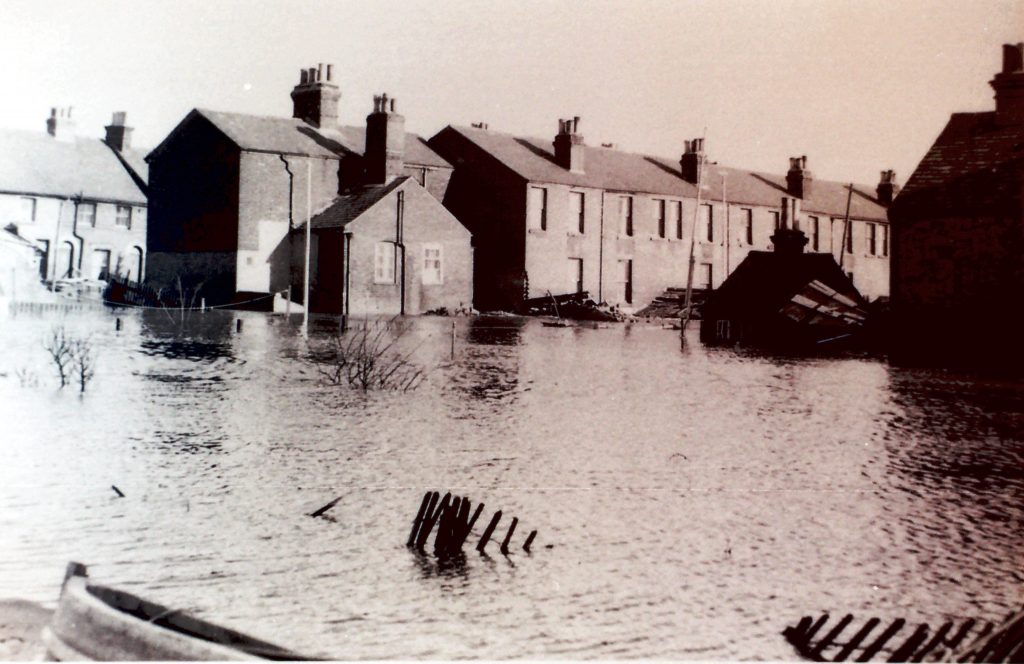
Flooded Harwich
I remember screaming and screaming and eventually telling my mother what I had seen. it began to go quiet and it was getting cold. We put our coats on to keep us warm. The wind was still very fierce and it had begun to rain again. We all tried to sleep, but sleep would not come. It was just beginning to get light and the wind and rain stopped. the water was still rising at six o’clock the next morning. Two rowing boats came past to tell us not to panic because there was help on the way.
We would all have loved a cup of tea, but there was no electricity. The Salvation Army were coming along the road in boats with tea for those who could reach it. It was about 12.30pm when the rowing boat eventually came to get us out. The road was like a river it seemed as if we were all out for the day in rowing boats, rowing about on the river. as we passed one boat, we hit it and our boat nearly went over. one of the men jumped out and saved us from capsizing.
As we reached dry land at Stour Road, we could see what had happened. The sea wall was gone and it looked like an enormous ocean. We all got into an Army truck which took us to the Drill Hall, where we found everyone we knew from Harwich. They gave us a nice hot cup of tea and something to eat. The water took a week to go down, we lost almost everything, My mind goes back to that awful night. Ruby Cooper-Keeble
The Harwich floods’ most tragic story
Most tragic story which has so far emerged from the Harwich flood epic is that of a young wife who was swept away to her death, together with the young baby she carried, while within a few feet of safety. Mrs Gladys Ellen Bruce, of 15 Albert Street, Harwich, was only twenty-three years old, the mother of three little children, when she perished in the cruel waters which poured over Bathside to render hundreds of people homeless.
Funerals of Harwich flood victims
MR. S.J.G. VINCENT
Mr Stanley John Goodall Vincent of 37 Grafton road, Dovercourt, had served with Trinity House at Harwich for thirty years, including the 1939-45 war period. He was aged 53 and leaves a widow, 2 sons and Three daughters.
MR. AND MRS F.G. SHIPLEE
Mr and Mrs Shiplee, of Station road, Harwich were buried together at Upper Dovercourt Cemetery, following a service conducted by the vicar of Harwich, the Rev. H.G.W.Bache, Well known at Harwich, Mr Shiplee was employed for many years as a delivery driver at Harwich Railway Station, and he started his early days when horses where used for the work instead of the present day Motor vehicles.
MRS. GLADYS BRUCE and PAULINE BRUCE
Twenty-three year-old mother of three children, Mrs Gladys Ellen Bruce of Albert Street, Harwich. was buried with her youngest child, 16 month old Pauline Margaret, at Upper Dovercourt Cemetery. The funeral service was conducted by the vicar of Harwich, the rev H.G.W. Bache.
MR. EDWARD JOHN ELLIS
Native of Harwich who worked in the shipwright’s shop at Parkeston Quay where he served his apprenticeship for a period of 48 years. Mr Ellis of Fernlea Road, Harwich, was another victim of the flood. The funeral took place at Upper Dovercourt cemetery, and was conducted by senior Major Robertson and senior Major Roberts of the Salvation Army.
MR. WALTER JAMES MALLOWS
Trinity house serviceman for 30 years Mr.Walter James Mallows of Vansittart street, Harwich, started his career at sea during the first World War when he was only 14 years old. He went through the war and afterwards joined trinity house service, serving until he was 50 years of age. The funeral took place at Upper Dovercourt Cemetery, following a service at All Saint’s Church Conducted by the vicar of Dovercourt, the Rev. A.H.Johnson.
MR. PEARL LOFTS
Popular licensee of the Anchor Hotel, Mr. Lofts was a lifelong resident of the town. During the first World War He served in Salonika with the royal army service corps and was a keen member of the British legion. Prior To becoming licensee of the anchor hotel. He was a well-known steward of Dovercourt Sports Club, The funeral took place at All Saint’s Church, Dovercourt and was conducted by the vicar of Dovercourt the Rev. A.H.Johnson.
24/09/1954. A Further gesture of friendship by the Norwegian Government, who gave the people of Harwich a number of typical Norwegian wooden houses to help relieve the suffering of homeless Harwich flood victims. the Norwegian Ambassador unveiled a plaque at Harbour crescent.
WILL IT EVER HAPPEN AGAIN?
The East Coast will never be free of the threat of flood, and man will continue to battle the sea in its place. Since 1953, greatly improved flood Warning systems and sea defences, plus the vigilance of the Anglian Flood Defence Committee, allow us, to sleep easy in our beds.
This simple monument near the Maritime Museum commemorates those Harwich residents who lost their lives in the Great East Coast Floods of 1953.
In Memory Of.
- Stanley Vincent, 53
- Frederick Shiplee, 74
- Lillian Shiplee, 63
- Gladys Bruce, 23
- Pauline Bruce, 16 months
- Edward Ellis, 68
- Walter Mallows, 60
- Pearl lofts, 64
March
In March the Dovercourt factory of Vacuumatic Limited, manufacturer of the world-famous bank note counting machines, received a 100,000 dollars order from Canada and America.
A local personality in the news was Mr. Jack Good, of Harwich, who retired from his career as a firemen, after serving with Harwich Fire Brigade for 38 years, He began his service when the fire engine was drawn by horses.
April
Thousands of football fans left Harwich and district on the 11th of April in the biggest exodus the area had known for the final of the F.A. Amateur Cup at Wembley. The game was played in front of a crowd of 100,000 people. 8,000 tickets were sold locally, 3 special trains laid on and some 60 coaches were also provided to convey the supporters to the ground. Mrs. Emily Tovell (landlady of The Royal Oak) was waiting at the Harwich HQ to receive the message and flash the half time score out through the town and out to eleven lightships in the North Sea.
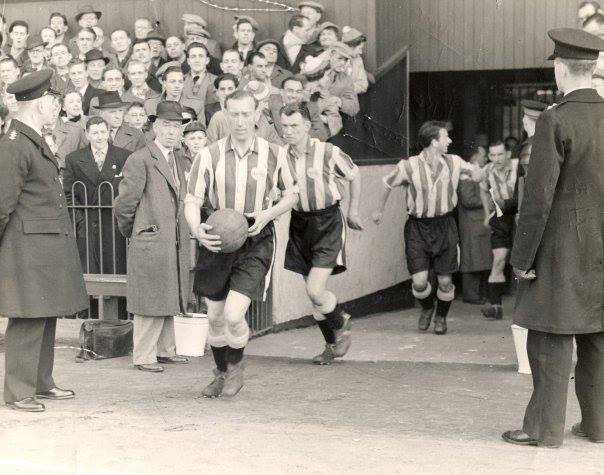
Harwich & Parkeston 1953
The message was then passed on to Trinity House depot, the stationers and fishmongers so that posters could be placed in their windows, allowing the few remaining Harwich residents to know the scores, and then at 4.55pm the Wembley radio plan was then repeated allowing the final score to be beamed out by Trinity House to seafaring fans. Pegasus though had the added incentive of making football history by being the only team to win two Wembley finals in two appearances. At half time the score stood at 3-0 to Pegasus and by full time the Pegasus players had scored three more goals, thus winning 6-0. The Harwich players struggled gallantly against the universities side and the supporters awarded the team full marks.
Although Harwich & Parkeston were beaten on the day, the skill which they had used to get them to the final will never be forgotten.
Kronprins Frederik.
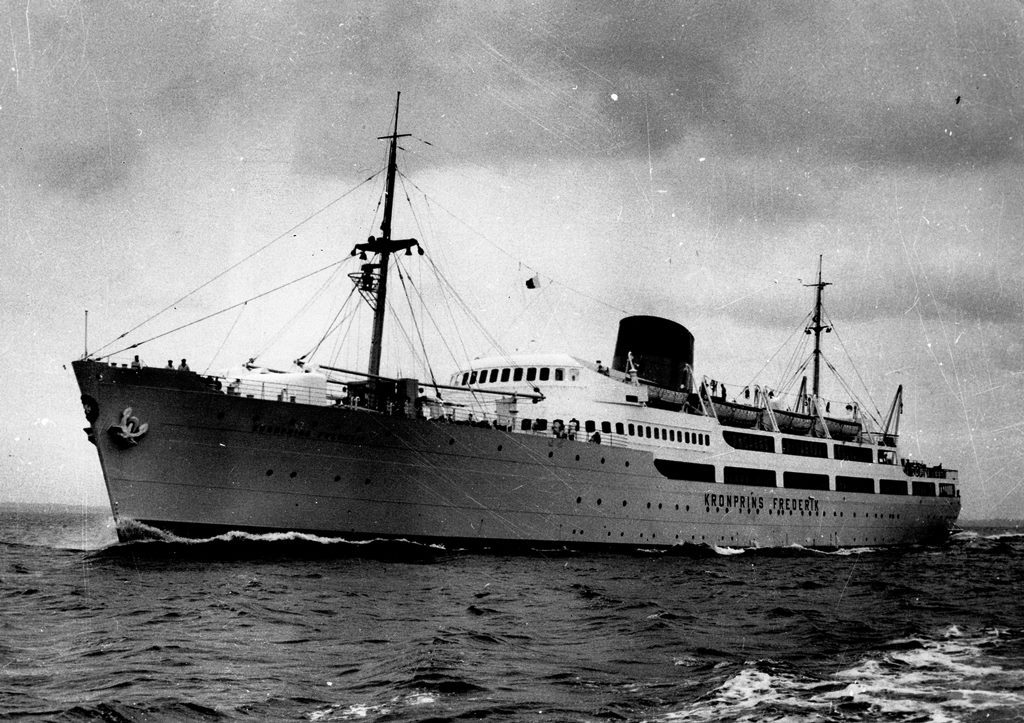
Kronprins Frederik
Kronprins Frederik was built at A/S Helsingør Jernskibs og Maskinbyggeri, Elsinore, Denmark for the Danish shipping company of Det Forenede Dampskibs-Selskab (DFDS). The ship was launched on 20 June 1940 with a length of 114.48 meters, beam of 15.2 meters, and draft of 5.66 meters. The ship was completed on 25 May 1941, towed to Copenhagen on 06 June 1941 and delivered to the owners on 19 June. Propulsion was provided by twin B&W 1050-VF-90 Diesel Engines (5294 kW) and twin propellers which gave the ship a cruising speed of 20.5 knots.
FIRE! FIRE! FIRE!
On 19th April 1953, disaster struck. At midday the “Kronprins Frederik” had arrived at Parkeston from Esbjerg all her passengers had disembarked, when at 1900 hours a fire was discovered. A fire which it was believed was caused by an electrical short-circuit. A fire which burnt out a third of the ship’s interior, a fire which engaged the services of over 100 firemen, 20 pumps, some with hoses directing water from off the cranes at the quayside. A fire which called upon the services of the Reserve Naval Fleet, then stationed in Harwich harbour, and the fire float attached to R.A.F. depot at Felixstowe likewise rendered service.
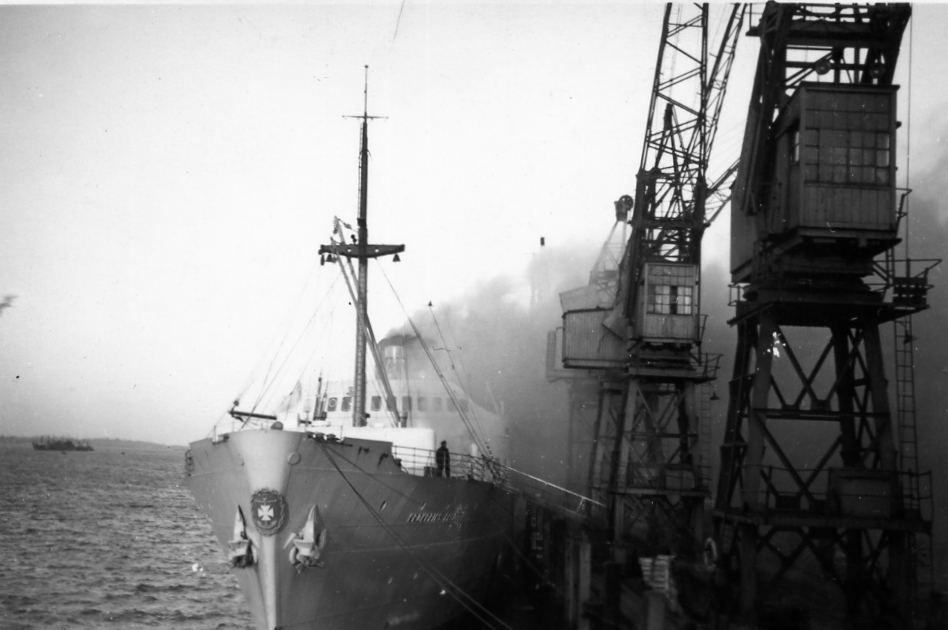
Kronprins Frederik on fire
A most dramatic moment came, when, at 0240 hours Monday morning, the blazing ship gave a tremendous lurch outward from the quay snapping her ropes as if they were silken threads and shook the whole quayside as her massive keel forced the piles with all the weight of her 4,000 tons behind her. Came the light of dawn the burning ship began to keel over as more ropes snapped and a proud magnificent ship rolled over into the water to rest with her starboard side on the mud of the river bed. Messages of sympathy which reached the Captain, included one from H.M. King Frederik IX.
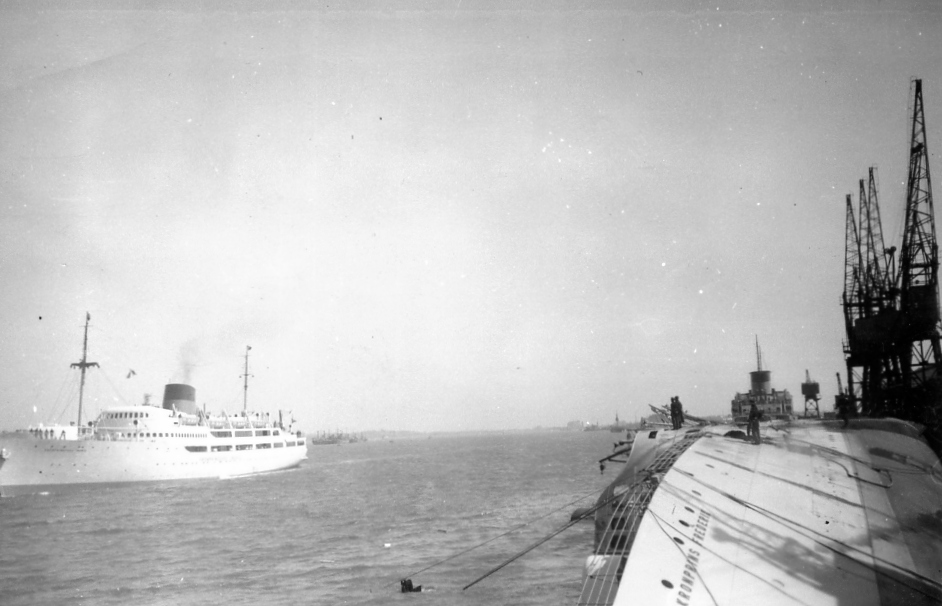
On the river bed
After a massive salvage operation by the Liverpool and Glasgow Salvage Association, it was not until Wednesday 26th., August that the ship was back on an even Kiel. Throughout the entire salvage operations, the master of the ship, Captain S. Lauridsen was in attendance, with the exception of a few days when he returned to his home in Denmark for the occasion of his silver wedding anniversary.
On Saturday 11th,m September 1953, to the cheers of the people of Harwich, to who the ‘Frederik’ (to give the ship its popular name) had become so much a part of their lives; to the sound of sirens of ships gathered in the harbour; the Master together with a skeleton crew of engineers steered his stricken craft, under tow, back to her home yard in Elsinore.
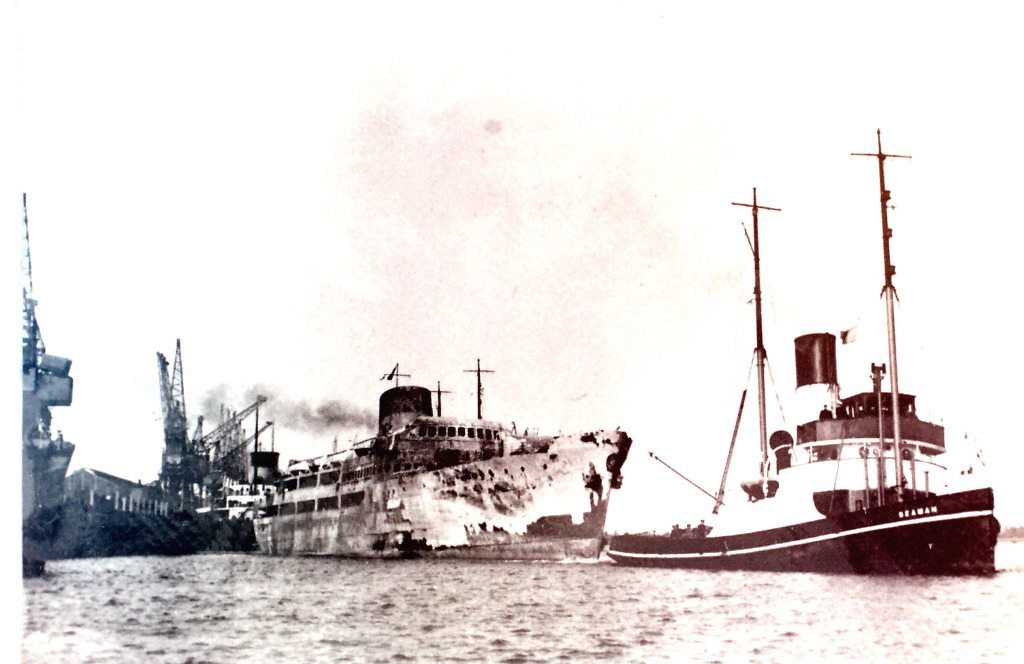
Under tow back to Elsinore
As the m.v. Kronprins Frederik went slowly through the harbour, Captain Lauridsen acknowledged this salute to his ship by hoisting a large new Danebrog (the Danish flag)… a symbol of the phoenix arising from the flames. Fortunately there were no casualties and the vessel was successfully towed to Denmark.
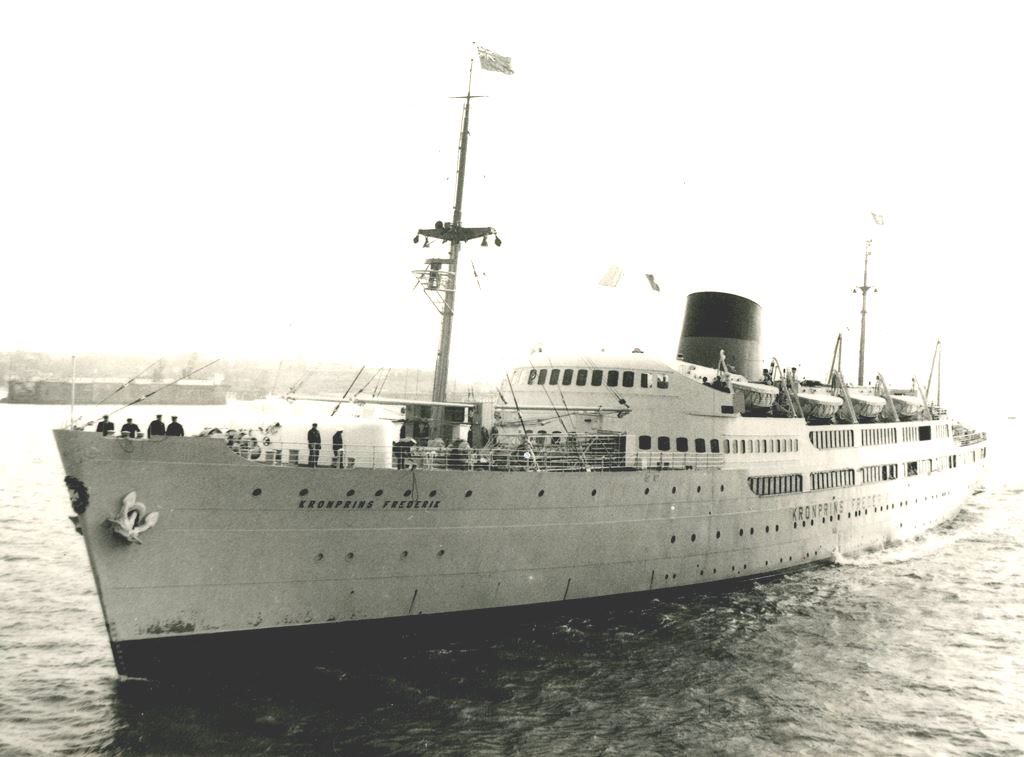
Returning to service.
This episode in her career of the vessel had a happy ending, when on April 20th., 1954 she re-entered the Esbjerg-Harwich service.
Despite her tragic beginning and the unfortunate fire, the ‘Frederik’ served the company and her namesake well. In 1951 the m.v. Kronprins Frederik left Parkeston Quay, with the late King Frederik and Queen Ingrid on board, at the conclusion of the Majestic State visit to Britain.
The ‘Frederik’ returned to Harwich in 1963 when the ship was leased out for private charter to the Carlsberg Distribution Co Ltd, London, for a passage departing from Harwich on 22nd May and sailing to Oslo, then on to Copenhagen, returning to Harwich on 29th May.
On 10th March 1976, the Kronprins Frederik was purchased by the Arab Navigation Company, Suez, Egypt, taking possession of the ship on 16th March and was renamed as the M/V Patra.
The Loss of the M/V Patra.
On the 23rd or 24th December 1976, the Patra departed Jeddah, Saudi Arabia on passage to Suez, Egypt with 353-387 passengers and 88-94 crew onboard. Many of the passengers were pilgrims returning from Muslim holy sites of Mecca and Medina, others were Egyptian workers from Saudi Arabia returning home with money and gifts for their families. There is quite a bit of conflicting information concerning the ship’s loss, but is known that a fire broke onboard in the ship’s engine room which, according to some reports, was followed by a series of explosions. One survivor’s account states that the passengers were ordered to jump overboard after the first explosion. Fire fighting efforts by the ship’s crew proved ineffective and it was later determined that the fire fighting equipment was obsolete and in poor condition. It is known that the order to abandon ship was given, with the captain, Mohammed Hammed, later stating that he and the crew had to chase many of the passengers off the sinking ship with axes because they refused to leave their baggage and possessions onboard. Other survivors also stated that the crew of the ship were among the first to man the lifeboats which were said to have been full of holes. As the passengers and crew were abandoning the ship, half a dozen passing ships came to their rescue, picking many of the people in the water and lifeboats, with the Russian tanker Lenino rescuing the captain and 201 of the survivors. The Patra, still in flames, sank a few hours later on the early morning of 25th December 1976 at position 21.56N / 38.28E in over 450 meters of water. Of the passengers and crew onboard, 102 lives were lost.
May
Countless acts of heroism by members of the amid the more spectacular work of a host of rescuers high-lighted the dramatic North Sea crash in which the Harwich-bound British Railways vessel Duke of York was cut in two, 30 miles off the English coast.
The Duke Of York.
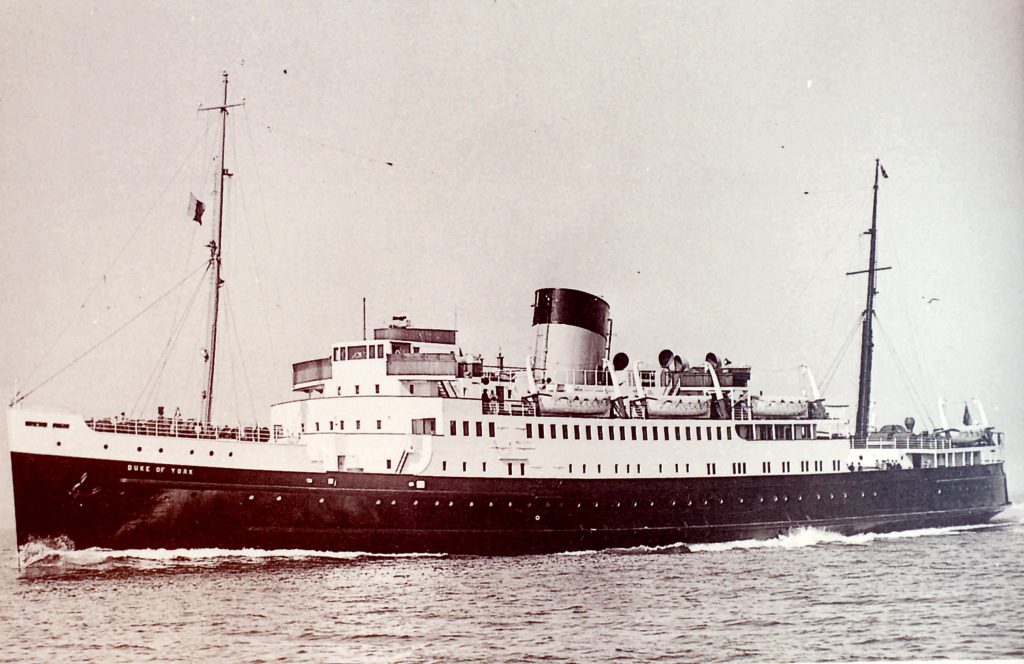
Duke of York
The British Railways 4,190 passenger steamer, Duke of York, set sail on her regular crossing from Hook of Holland to Harwich at 23.00 on 5th May 1953 with 473 passengers and 72 crew. It has been thick fog throughout the voyage when at 04.33 B.S.T the ship was 1.5 miles east of the Gabbard Light Vessel when she was struck on her port side by the American supply ship “Haiti Victory” which was on her way from New York to Bremerhaven with military equipment.
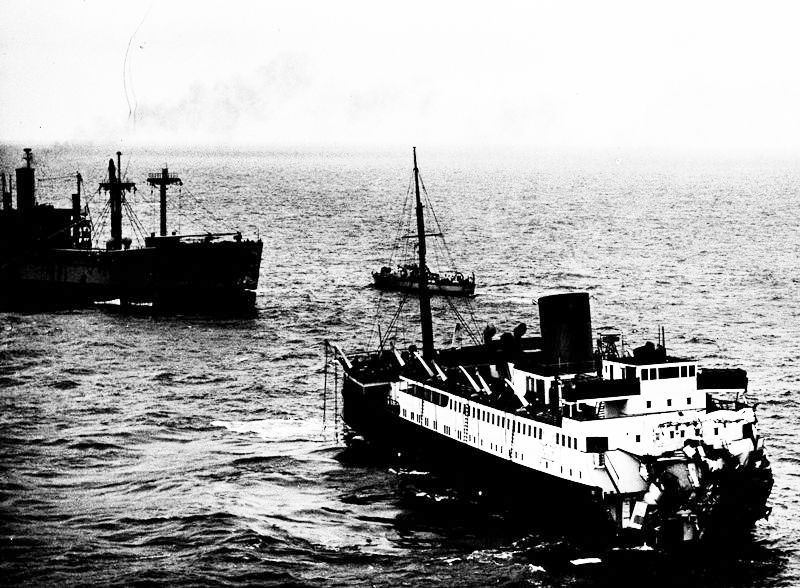
Haiti Victory & Duke of York
The Bow of the American vessel sliced through the British vessel leaving the bow section opened like a hinged door. The bow finally broke adrift still containing some passengers and crew. The Haiti Victory manoeuvred alongside “Duke of York” and was able to transfer 300 passengers. Several ships in the area answered the SOS including Dewsbury and Norfolk Ferry. The tugs Empire Race, Sun XVII and Goliath towed her stern first, to Parkeston Quay Arriving at 23.20.
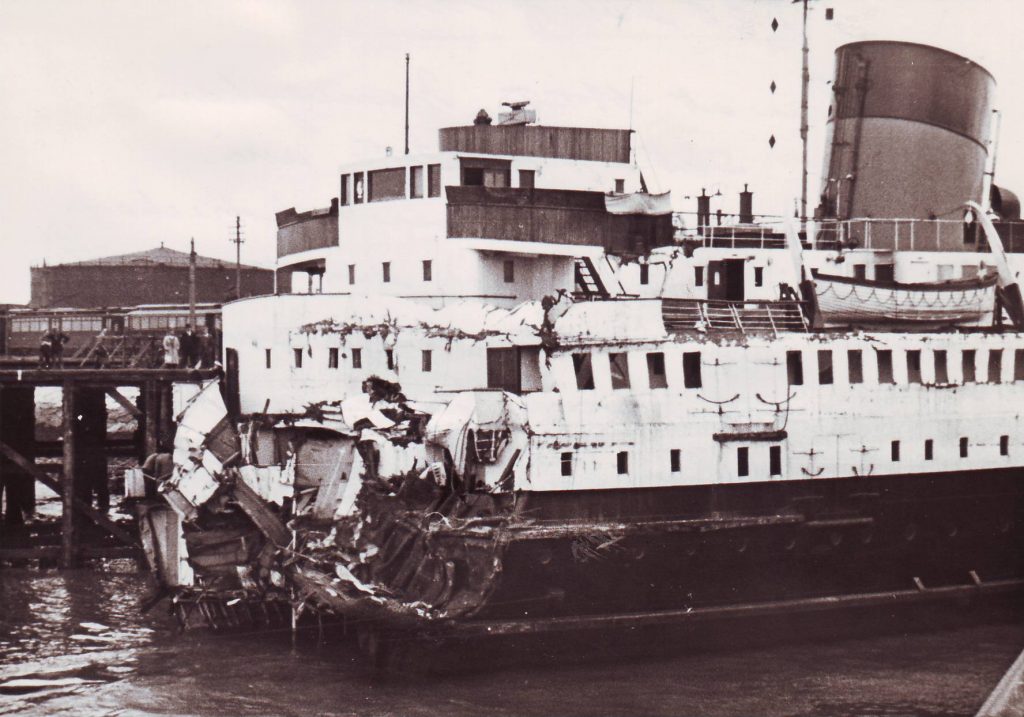
Alongside Parkeston Quay
Duke of York arrived back at Parkeston Quay shortly before midnight. she was moored to buoys in the river before being taken alongside some eight hours later. Six bodies were recovered,one passenger remained unaccounted for and eight passengers were injured. Four “very serious” casualties were reported to be among 91 survivors picked up by the United States ship American. The American landed them at Dover, on the south coast. Other survivors were taken aboard the Haiti Victory and British Railways ships which went to the rescue. Some of them began landing at Dover later in the afternoon.
Survivors of the Duke of York told of a “night of terror.” After the collision passengers ran around the decks screaming “We are sinking” and “Abandon ship.” Many escaped in pyjamas and came ashore wrapped in blankets. They had had no time to dress. A young Royal Signals courier, Tony Coleman said: “We were awakened by children screaming and a terrific jarring and shuddering of the ship. “We heard people yelling and calling for help.” The ship was rebuilt with a new 90 feet long bow section this increased the tonnage to 4,325, arriving back at Parkeston Quay on 22nd january 1954. In 1963, Duke of York was sold to Chandris Lines. First renamed York, she and entered service in 1964 as the Fantasia. She ran mainly on cruises in the Eastern Mediterranean, with some winter charters to religious tour groups. Before being scrapped in Spain in 1975.
Inquest.
The master of the British Railways ferry Duke of York said at the inquest that, after being warned of fog patches, he saw a ship coming towards him “very fast.” Captain Rowland Vincent Adams said the visibility was about a quarter of a mile. When he saw the ship on the port bow he put the Duke of York’s engines hard astern and gave three short blasts on the whistle.
“The collision occurred about half a minute afterwards,” he said “As it was inevitable, I told the second officer to call all hands out and I stopped the port engine to ease the blow.”
Memories of a Stewardess.
I’ll never forget this tragic sea journey. A Former passenger ferry stewardess recalled the day over 40 years ago when she almost Lost her life in a tragic accident at sea.
On May 6, 1953, five passengers died after a 7,600 tonne American ship, the Haiti Victory, plied into the Parkeston bound Duke of York, tearing away its bows. the then young frightened stewardess Evelyn Lovett had worked on the ship since 1948. She describes the night in 1953 as “the most traumatic” of her life. I can remember every detail. I shall never forget it. I was in bed and heard the change of engine so I got out and as I stood I was thrown on to the settee. There was a terrific noise. I had a family to look after four men, four women, and children, and one of the wives panicked so the husband handed me the child, then someone threw me and the child, who was just one year old, from the boat deck of the “Duke” to A deck of the Haiti Victory which had come alongside to help.
The rescue operation took almost 12 hours. within an hour of the collision, lifeboats and any nearby vessels were diverted to the scene – About 30 miles of the English coast. Locals brought blankets to the quayside and members of the Parkeston Ambulance Division provided stretchers and hot water bottles. Had it not been for the Duke of York’s skipper’s skilful captaining, more people would have Been certainly killed. There was an airtight door and had the Haiti hit us six feet further along, the door would have been damaged, we would have gone down and I wouldn’t be telling this story.
It was an experience I will never forget, stuck in the middle of the North Sea not knowing how many people would get out alive.
Captain Roland Vincent Adams.
Rowland Vincent Adams was born in Portsmouth on the 9th April 1899 and was married at All Saints Church in Dovercourt in 1930. He had a formidable fighting ability, which he displayed and maintained by way of example; He was a man who at all times led from the front. He had a genuine interest in people and a very keen sense of humour. At the time of the disaster, Captain Adams had been qualified as a Ships Master for 33 years, following the disaster the management of the shipping company wanted a head on a plate. Captain Adams stood firm and remained adamant that he was innocent until proven guilty. At the conclusion the examination board were unanimous that Captain Adams had fully complied with Maritime Law and Regulations and that he had, without fault, adopted the correct procedures to be followed in regard to all other relevant Safety and Operational matters.
Following his retirement Captain Adams went to live in Dawlish in Devon where he died on 11th November 1979.
Captain Roland Adams O.B.E 1899-1979
William Frank Bramhill.
Officer William Bramhill showed great heroism that foggy night in 1953. In the early hours of May 6, when suddenly the American troopship, Haiti Victory, loomed out of the murk. Bramhill, who was second mate, was on watch as the ship crashed into Duke of York forward of the bridge, slicing her in two. Bramhill and an officer from Haiti Victory, Howard Ridenour, sprang into action, working chest-deep in the sinking forward section, hacking and cutting with axes and knives to free trapped passengers, of which there were many. William Frank Bramhill was born in Liverpool on January 30 1913, and joined the Merchant Navy seamen’s training ship Indefatigable on the Mersey aged 13.
He served with T&J Harrison, Elder Dempster and MacAndrews, as he worked his way from seaman to navigating officer. During the Second World War he saw action in the Atlantic and Indian Oceans, and in the Mediterranean. In 1941 Bramhill was commended by Winston Churchill for his brave conduct in firing on a U-boat which surfaced next to his ship. As with great difficulty he angled his Oerlikon gun at the conning tower, a couple of the seamen pelted the sub with peeled potatoes from the galley, hurling Scouse insults at the “Jairmans”. Later in the war, Bramhill was in the merchant vessel Empire Newton at Juno and Gold beaches immediately after D-Day. In 1946 Bramhill moved to Harwich, joining the LNER fleet, later Sealink, and winning his masters’ certificate. He first sailed as captain in the late 1950s. On retirement in 1977 he feared that growing dahlias in his East Bergholt garden would “not have the same thrill as a NW 10 gale” but was glad that seagulls ventured as far as his village. He married, in 1939, Rita Unwin; they had five sons.
The collision caused eight deaths. There would have been far more but for the presence of a sailor with the experience, skill and courage of Will Bramhill.
Captain William Bramhill 1913-1997
June
Harwich was feeling well satisfied with the ambitious nine-day programme of Coronation celebrations which marked this historic occasion in June. Despite the weather and the town;s own special problems everyone rose to the occasion and threw themselves wholeheartedly into the various events.
Residents and business folk decorated their premises, Dances were held at the Alexandra Hotel,Cliff Hotel,and Cliff Pavilion. many local residents had bought television sets especially to watch the coronation live, Street parties were held in the afternoon with the residents of parkeston holding a party at Hamilton Park.
July
Fifty years jubilee of the National Association of Worker’ Educational Association was marked at Harwich by the local branch’s entertainment of 50 North Essex members. A varied programme included an exhibition of some of the borough muniments, including the Royal Charters.
August
Harwich and Dovercourt traders blamed the Coronation and bad weather for their shortest-ever season, and thought that even a good September could not save the situation from their point of view.
September
Early in September, the residents of Bathside rose as one man to express their dissatisfaction with the speed at which their homes were being restored and petitioned the Borough Council to hurry the work of repair before winter.
October
Although not a brick had been laid for the erection of the new Hill Secondary Modern School at Low-road, Dovercourt, it was already known that in 1960 it would be 220 places short for the number of pupils to be accommodated.
November
November saw the launching of the “no profit” football pool at Harwich, when it was announced that profits from “Generosity Pools” would go to help charity and sport.
December
News features of the past month were the introduction of the Rotarians’ Christmas Tree of Goodwill as a new venture in the town, the “death” of the proposal to form a Port Development Association at Harwich, and criticism of the points system for allocation council houses.
For many years to come Harwich folk will say “Do you remember 1953?” And what cause for memories will everyone have who lived in the twelve historic months.
Photo Gallery
Click “play” to start the gallery slide show.
We are adding more information to this site on a regular basis, if you wish to submit any photos or provide any information, please use the contact page at the bottom of the screen.
Copyright: We attempted to get the consent of copyright holders to use this material for nearly all of the photographs on the website.
In the few cases where names are available, a thorough search was made using telephone directories, photographic copyright directories, People Search and Google Area Search. None of the copyright owners could be traced in this way and we believe we have exhausted all reasonable avenues.
The consensus opinion of these authorities was that if any two of the following situations applied we would be deemed to have taken sufficient action to avoid infringing copyright laws:
No financial gain will be made in relation to the photos.
The website owner undertakes to remove any photograph from the website where offence is caused. All the above conditions have therefore been met.
Acknowledgements.
William Bramhill, The Standard.
